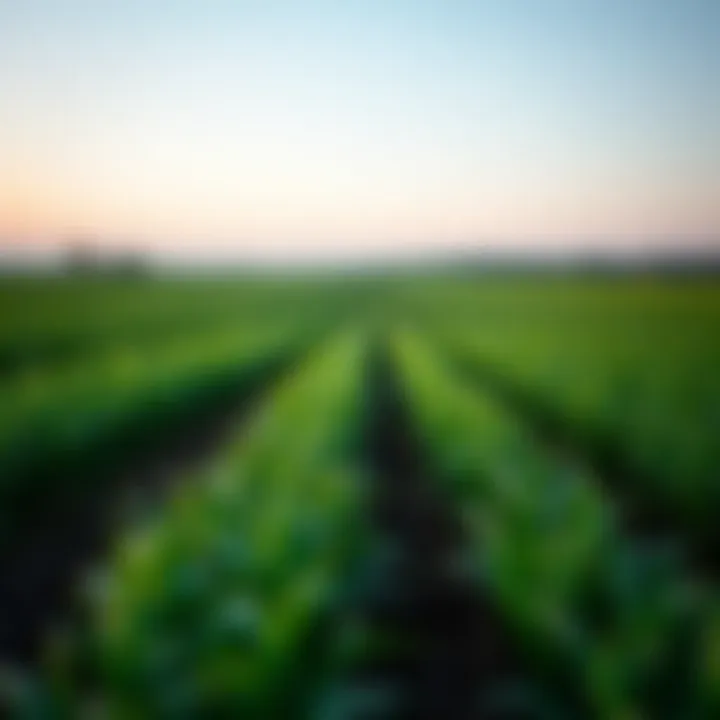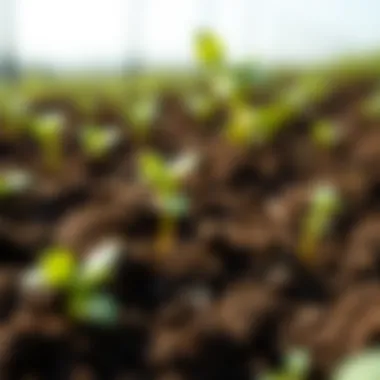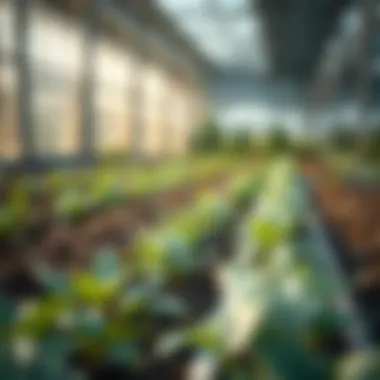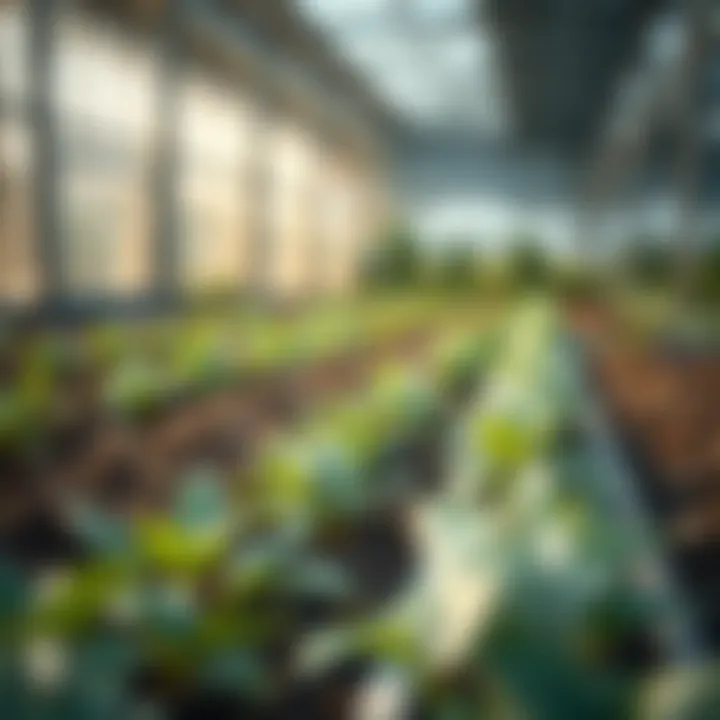Exploring Agronomy: Principles and Modern Advancements


Overview of Research Topic
Brief Background and Context
Agronomy as a science dates back thousands of years. Ancient civilizations recognized the importance of soil fertility and crop rotation for sustainable food production. This longstanding relationship between humans and farming illustrates how agronomy shapes our ability to feed a growing population. Today, agronomy is not only a field of agricultural study but also a discipline integrating biology, chemistry, ecology, and technology.
Modern agriculture faces a multitude of challenges, from soil degradation and pest infestations to drastic climate changes threatening crop yields. These challenges compel agronomists to refine their approaches continually. Traditional methods stand alongside innovative advances like precision agriculture, leveraging data and technology to optimize crop production.
Importance in Current Scientific Landscape
In the contemporary scientific landscape, the relevance of agronomy cannot be overstated. It serves as the backbone for developing strategies that ensure food security while preserving environmental health. Agronomists tackle pressing issues such as:
- Soil health: Understanding how soil composition affects crop productivity.
- Pest management: Finding sustainable solutions to pest outbreaks without harming ecosystems.
- Climate adaptation: Researching how to adjust agricultural practices in response to unpredictable weather patterns.
Given the intricate relationship between agriculture and climate, focusing on agronomy can potentially lead to solutions that promote sustainable practices and minimize environmental impact. The role of agronomy extends beyond mere food production—it encompasses the ecosystem’s health and our society's future well-being.
"The future of agriculture is not about increasing yields alone, but rather ensuring that yields are sustainable and equitable."
Methodology
Research Design and Approach
The exploration of agronomy demands a methodological framework that promotes both theoretical insights and practical applications. Researchers often employ a multifaceted research design that combines both experimental and observational studies. This hybrid approach allows for more comprehensive analyses of how various agronomic practices impact soil health, crop performance, and ecosystem balance.
Data Collection Techniques
Data collection in agronomy commonly involves:
- Field experiments: Testing different agricultural practices under controlled conditions to observe their effects on crop yields and soil health.
- Surveys and interviews: Engaging with farmers to gain insights into their practices and challenges in the field.
- Remote sensing: Utilizing technology to monitor crop conditions over large areas, which aids in evaluating agricultural sustainability.
Through these techniques, agronomists gather valuable data that inform best practices and foster sustainable agriculture globally. It’s through such rigorous methodologies that the continuous improvement of agronomy unfolds, steering the future of farming towards a more sustainable direction.
Overview of Agronomy as a Discipline
Agronomy, as a multifaceted branch of agricultural science, plays a pivotal role in fostering sustainable farming practices and enhancing food security. It integrates various scientific principles to optimize crop production while maintaining ecological balance. In this section, we will delve into the definition, historical context, and significant importance of agronomy in contemporary agriculture. By providing a comprehensive understanding, we aim to underscore its relevance and potential impact on future agricultural endeavors.
Definition and Scope
Agronomy can be succinctly defined as the science and practice of soil management and crop production. This field encompasses a broad spectrum of activities, from understanding soil chemistry and biology to applying innovative farming techniques. Agronomists study the interrelations of crop varieties with their environments, determining how best to enhance yields while protecting resources. Crucially, agronomy is not confined to traditional farming methods; it extends to include aspects like agroecology, crop rotation, and even precision farming technologies.
The scope of agronomy touches on several vital segments, including:
- Soil Fertility: Understanding nutrient dynamics and improving soil health.
- Water Management: Implementing irrigation and drainage systems.
- Crop Management: Developing practices that maximize output while minimizing environmental impact.
This broad scope ensures agronomists contribute significantly to innovative agricultural solutions, responding to the challenges of a growing population and climate variability.
Historical Context
The roots of agronomy can be traced back to ancient civilizations, where farming emerged as a crucial practice for survival. Early agronomists, though not formally recognized, laid the groundwork by observing crop cycles and productivity based on varying soil types. Fast forward to the 18th and 19th centuries, significant advancements occurred with the advent of scientific methods in agriculture. Jethro Tull, a pioneering figure, introduced seed drilling, revolutionizing planting efficiency.
As the science progressed, institutions began to emerge; the establishment of agricultural colleges in the late 19th century promoted systematic study and research. The Green Revolution of the mid-20th century marked a transformative phase, bringing high-yield crop varieties and synthetic fertilizers to the forefront, drastically boosting productivity. Today, agronomy stands at a crossroads once again, as sustainable practices become imperative amidst rising environmental concerns.
Importance in Modern Agriculture
In today’s world, the significance of agronomy cannot be overstated. As pressures mount from population growth and climate change, agronomy serves to bridge the gap between food demands and sustainability. Some of the key points to consider include:
- Enhancing Food Security: Agronomy directly affects yield improvements and resource management, essential in feeding the global population.
- Sustainable Practices: Modern agronomy emphasizes practices that reduce environmental footprints, advocating for methods like organic farming and precision agriculture.
- Research and Innovation: Continuous research in agronomy leads to the development of new crop varieties and technologies that adapt to changing climates, ensuring resilience in agricultural production.
Agronomy is the backbone of modern agriculture, intertwining scientific inquiry with practical application to carve pathways toward a sustainable future for food production.
In summary, the overview of agronomy establishes a foundation for understanding its multifaceted nature, historical evolution, and pressing importance in today's agricultural landscape. Acknowledging these elements prepares us to delve deeper into the fundamental principles that govern agronomy and its applications.
Fundamental Principles of Agronomy
The foundation of agronomy is built on several core principles that govern how crops grow and thrive in various environments. Understanding these principles is crucial as they influence not just the yield of the crops but also the sustainability of agricultural practices. By delving into aspects such as soil fertility, water management, and plant physiology, agronomists can develop strategies that support both productivity and environmental health.
Soil Fertility and Health
Soil fertility is a cornerstone of successful agronomy. Fertile soil is packed with nutrients, which are essential for plants to grow. When soil is healthy, it holds more water and sustains richer ecosystems. Key factors contributing to soil health include the organic matter content, pH levels, and the presence of essential minerals like nitrogen, phosphorus, and potassium.
To maintain soil fertility, farmers often utilize practices such as:
- Crop rotation: This method involves alternating different types of crops in the same area across seasons. It helps replenish nutrient levels and break pest cycles.
- Cover crops: Planting cover crops during off-seasons protects the soil from erosion and enhances its organic matter.
- Soil testing: Regular testing can help in accurately assessing nutrient levels and identifying deficiencies or surpluses.
However, it is not just about adding fertilizers; implementing practices that promote biological activity in the soil is equally important. Healthy soils are often teeming with earthworms and microorganisms, which contribute to breaking down organic matter, thus making nutrients available to plants.
"Healthy soil is the foundation of successful farming and essential for sustainable food production."


Water Management Techniques
Water is another critical element in agronomy, making proper management techniques imperative for crop success. The availability and usage of water can make or break agricultural operations. Effective water management can involve several strategies to ensure crops receive adequate moisture without wastage.
Some common water management practices include:
- Irrigation systems: Methods such as drip or sprinkler irrigation provide controlled amounts of water directly to plant roots, minimizing evaporation losses.
- Rainwater harvesting: Capturing and storing rainwater for use during dry seasons can help maintain availability without relying solely on groundwater.
- Soil moisture management: Techniques like mulching can reduce water evaporation and assist in maximizing water retention within the soil.
These practices not only enhance crop yields but also contribute to sustainable water use, addressing the alarming issue of water scarcity in many parts of the world. The careful balance of water use must be maintained to prevent salinity and depletion of aquifers over time.
Plant Physiology
Understanding plant physiology is fundamental when it comes to agronomy. It encompasses how plants function, including how they photosynthesize, absorb water, and respond to their environment. Knowledge of these processes helps agronomists optimize conditions for plant growth.
Key aspects of plant physiology involve:
- Photosynthesis: The process where plants convert sunlight into energy is pivotal. Plants need adequate light, water, and carbon dioxide to maximize their growth potential.
- Nutrient uptake: Roots play a crucial role in nutrient absorption; thus, their health can significantly impact crop yield. Understanding root architecture can inform planting depth and spacing.
- Stress responses: Plants often face stress from pests, diseases, or environmental conditions like drought. Recognizing how plants respond to these stresses can help develop more resilient crop varieties.
In summary, grasping the basic principles of agronomy allows for a nuanced understanding of agriculture. Each element—be it soil, water, or plants—interconnects to create a sustainable agricultural practice.
For further reading:
These principles not only guide current practices but also shape future innovations in agronomy, ensuring that agriculture meets the challenges of tomorrow.
Crop Production Systems
Crop production systems form the backbone of agronomy, influencing not only agricultural output but also the ecological sustainability and economic viability of farming practices. The choice of crop production systems affects how efficiently resources are utilized, how resilient crops are to pests and diseases, and their overall contribution to food security. Each method offers distinct advantages and challenges, requiring careful consideration from farmers and agronomists alike. Understanding these systems serves not only to maximize productivity, but also to ensure that agricultural practices align with environmental stewardship.
Types of Cropping Systems
When discussing crop production systems, it’s essential to delve into the various methods farmers employ to cultivate their crops. Among these, monoculture, polyculture, and crop rotation stand out as three distinct strategies that offer different benefits and limitations. Each has unique characteristics that can profoundly impact both agricultural practices and the environment.
Monoculture
Monoculture refers to the practice of growing a single crop species over a wide area and for several consecutive seasons. This approach is often favored for its efficiency in resource use—farmer can easily manage a specific crop type by optimizing for its particular needs. The key characteristic of monoculture is the focus on a single variety, which streamlines processes related to planting, harvesting, and pest management.
However, the reliance on monoculture can come with its own drawbacks. While it allows for simplified farming procedures, it can lead to soil nutrient depletion and increased vulnerability to pests and diseases, as pathogens can thrive in the uniform environment. In the context of sustainability, monoculture raises concerns because it tends to require higher inputs of chemical fertilizers and pesticides, which can negatively affect surrounding ecosystems.
Polyculture
Contrasting monoculture, polyculture involves growing multiple crop species in the same space. This method aims to mimic natural ecosystems, fostering biodiversity and resilience. A significant advantage of polyculture lies in its ability to reduce pest and disease pressures, as the varied plant species can interfere with the life cycles of harmful organisms. For example, intercropping a legume with a cereal can enhance nitrogen availability in the soil, benefiting both species.
However, polyculture can be more complex to manage, requiring a more in-depth understanding of how different crops interact with each other. This complexity can lead to challenges in achieving peak efficiency during planting and harvesting times. Farmers need to carefully consider species compatibility and timing to make polyculture a successful endeavor.
Crop Rotation
Crop rotation is a farming practice where different crops are planted in succession on the same land. This strategy interrupts pest and disease cycles, improves soil health, and optimizes nutrient use. The key characteristic of crop rotation is its intentionality; by pairing crops with different nutrient needs and growth habits, farmers can enhance soil fertility and structure, which is particularly vital for sustainable agriculture.
One significant advantage of crop rotation is its ability to break up cycles of soil-borne diseases and pests, thus promoting healthier crops over time. However, implementing crop rotation requires planning and knowledge of local soil conditions and climates. Not all crops are suitable for all soil types, and mismatched rotations can lead to reduced yields. Educating farmers about the best combinations can greatly enhance the effectiveness of this practice.
Mechanization in Crop Production
The advent of mechanization in agriculture has dramatically transformed crop production systems, allowing farmers to increase productivity while reducing manual labor. Modern machinery, ranging from seeders to harvesters, has enabled extensive cultivation and streamlined processes, leading to higher efficiency. However, as mechanization increases, there’s a growing need to balance technology reliance with environmental considerations to ensure sustainable practices are upheld.
Precision Agriculture
Precision agriculture embodies the use of technology to manage field variability in crops by using data analytics and GPS mapping. This approach allows farmers to apply inputs more efficiently, fine-tune water, nutrients, and pesticides application based on specific field conditions. The promise of precision agriculture lies in its potential to enhance productivity while minimizing environmental impacts. As data-driven methods evolve, they offer insightful ways to optimize resources, increase yield, and make informed decisions that align with sustainable agricultural practices.
Pest Management and Crop Protection
Pest management and crop protection are crucial components in the journey of sustainable agriculture. This realm involves strategies that not only safeguard crops but also uphold the integrity of the ecosystem. In an age where food security and environmental health are paramount, understanding how to effectively manage pests is vital for both producers and consumers.
Pest management is not merely about combatting threats; it's about a nuanced approach that balances agriculture and ecology. A well-thought-out pest management plan can lead to healthier plants, higher yields, and less reliance on harmful chemicals, which ultimately benefits the environment as well. With that in mind, let’s explore the various strategies and methods used in this field.
Integrated Pest Management
Integrated Pest Management (IPM) is a holistic approach combining several strategies to manage pests sustainably. This method’s fundamental principle is to use pest control techniques that are environmentally friendly while ensuring crop protection. Rather than relying solely on chemicals, IPM promotes using biological and cultural controls, making it a more diversified and environmentally aware system.
Key elements of IPM include:
- Monitoring and Identification: Regular scouting allows farmers to identify pest populations and their life cycles accurately.
- Threshold Levels: Establishing action thresholds helps determine when pest management action is necessary, preventing unnecessary treatments.
- Diverse Tactics: Cultural practices, biological controls, and targeted pesticide use are combined to control pests with minimal environmental impact.
By focusing on the life cycle and habitat of pests, IPM seeks to interrupt their activities without causing harm to non-target species. The beauty of this method lies in its adaptability—farmers can tweak their strategies based on specific crop needs and ecosystem dynamics.
Chemical Control Agents


While the trend leans towards using less chemical means, there are still situations when chemical control agents become necessary. This includes scenarios where pest populations exceed established thresholds or when rapid action is required to protect a harvest. It’s essential to use these agents judiciously.
Chemical control can be broken down into two categories:
- Insecticides: Target specific insect pests but have to be applied during certain growth stages to avoid collateral damage.
- Herbicides: Focus on unwanted plant species that compete with crops for resources. Selective herbicides can mitigate risks by targeting specific weeds while leaving the crop unharmed.
It's crucial to recognize that while chemical agents may offer immediate results, over-reliance can lead to resistance among pest populations. Herein lies the importance of integrating these chemicals into a broader pest management strategy, ensuring efficacy and sustainability.
Biological Control Methods
Biological control methods harness natural predators and parasites to manage pest populations. This strategy's charm lies in its sustainability; rather than introducing artificial substances, it encourages a biodiversity that can lead to a natural balance.
Some key practices in biological control include:
- Predators and Parasitoids: Introducing insects like ladybugs that feed on aphids or parasitoids that lay eggs in pest species can effectively reduce their populations organically.
- Pathogens: Utilizing microorganisms to attack specific pests can be a powerful method, often seen in the use of certain fungi or bacteria that are lethal to pests but harmless to crops.
- Companion Planting: Some plants repel pests while attracting beneficial insects. This historical wisdom is being increasingly validated by modern science.
By encouraging the ecosystem's natural dynamics, biological control presents a long-term solution to pest management that aligns well with sustainable practices.
The choice of pest management strategy should be informed by the pest life cycle, environmental considerations, and economic feasibility, ensuring a comprehensive approach to crop protection.
Impact of Climate Change on Agronomy
Understanding the repercussions of climate change on agronomy is crucial for modern farming practices. As weather patterns shift and extreme events become more frequent, farmers and researchers face pressing challenges. These challenges span various angles: from altering crop yields to necessitating new adaptation strategies. Importantly, what’s at stake is not just agricultural productivity but also food security and environmental sustainability. This section delves into the nuanced relationship between climate change and agronomy, highlighting critical impacts on crop yield and proposed adaptation strategies.
Effects on Crop Yield
Climate change has shown to affect crop yields in multiple ways. The most immediate impact appears through shifts in temperature and precipitation patterns, which directly influence plant growth stages, nutrient absorption, and pest dynamics.
- Temperature Fluctuations: Increased average temperatures can lead to shortened growing seasons. Some crops might thrive in warmer climates, but many staple crops like wheat and rice could suffer. Higher temperatures disrupt flowering times, leading to decreased yields.
- Drought and Flooding: Climate change has made severe weather events, such as droughts and floods, more common. Drought can stress plants, reducing their ability to produce viable grains. On the flip side, excessive rainfall can lead to waterlogging, which may suffocate plant roots and stunt growth.
- Pest and Disease Pressure: As the climate warms, various pests and diseases may thrive in regions previously unsuitable for them. Crop losses due to pests may increase dramatically, especially if farmers are unprepared to adapt to these changes.
"The undeniable truth is that climate change is already reshaping agricultural landscapes, compelling us to rethink our strategies for crop production."
To illustrate, consider the case of coffee production in Brazil, where rising temperatures and altered rainfall patterns have reduced coffee yields significantly. Farmers now struggle with both quality and quantity, forcing many to reconsider their crop choices and cultivation methods.
Adaptation Strategies
To address the challenges posed by climate change, agronomists and farmers are actively developing and implementing adaptation strategies. Here are some tactics that have gained traction:
- Crop Diversification: By growing a variety of crops, farmers can reduce the risk of total crop failure. Diversification helps in maintaining productivity, considering that different crops may respond variably to climatic changes.
- Resilient Crop Varieties: Research in plant breeding has led to the development of resilient crop varieties that can withstand extreme heat, drought conditions, or pest pressures. These improved crops can play a pivotal role in ensuring stable yields in uncertain conditions.
- Water Management Practices: Techniques such as rainwater harvesting or constructing efficient irrigation systems can help mitigate water scarcity. Better management of existing water resources is essential for sustaining crop yields in times of drought.
- Agroforestry: Combining agriculture with forestry techniques not only increases biodiversity but also improves soil health and water retention. Planting trees alongside crops can provide shade, which helps crops cope with extreme heat.
- Education and Training: Farmers need access to knowledge regarding sustainable practices and new technologies that can improve resilience against climate shocks. Training programs can ensure that they are well-informed and prepared.
Adapting to climate change is not a one-off effort but a continually evolving process. Farming communities need to stay vigilant and responsive to the changes in their environment, integrating new findings and technologies into their practices. The importance of these strategies cannot be overstated; they will determine the future viability of agronomy in the face of a changing climate.
Sustainable Agricultural Practices
Sustainable agricultural practices are fundamentally about fostering harmony between food production and the planet's health. As we face challenges like population growth and climate fluctuations, it's become increasingly vital to adopt methods that not only yield crops but do so with minimal environmental damage. These practices emphasize resource conservation, soil health, and ecosystem balance.
They reduce dependency on synthetic inputs and promote biodiversity, which hold long-term benefits for farming systems. The idea is simple: healthy soil produces healthy plants. When farmers focus on improving soil vitality, they’re not just increasing their yields but securing the agricultural future for coming generations.
Organic Farming
Organic farming stands as a cornerstone of sustainable agricultural practices. This method relies on biodiversity, soil health, and ecological processes instead of synthetic fertilizers and pesticides. It's not just about avoiding harmful chemicals; it's about understanding how natural systems work and harnessing that knowledge to grow food effectively.
One notable advantage of organic farming is its emphasis on crop rotation and polyculture, which can dramatically enhance soil structure and fertility over time. In turn, this reduces erosion and improves water retention—crucial factors in areas that face variable weather patterns.
Here’s why organic farming matters:
- Soil Health: Regular application of organic matter improves soil structure and enhances microbial activity, leading to richer nutrient profiles.
- Reduced Pollution: By scrapping synthetic inputs, organic farmers lessen runoff that pollutes waterways.
- Biodiversity: Organic systems support a wider array of flora and fauna, promoting ecological balance.
While organic farming can sometimes lead to lower yields initially, the long-term benefits typically outweigh short-term losses. Farmers who embrace organic methods are not only helping their farms but also increasing resilience against pests and disease, easing their reliance on external inputs.
Agroecology
Agroecology merges agricultural science with ecological principles. This approach looks beyond mere productivity; it examines how food systems can be integrated into the health of the environment and local communities. Often viewed as a holistic view of farming, agroecology champions local knowledge and sustainable practices tailored to specific ecosystems.
The importance of agroecology in sustainable agriculture can be broken down into several key elements:
- Context-Specific Solutions: By taking local biodiversity and culture into account, agroecological practices ensure that farming methods are viable and appropriate.
- Improved Sustainability: Using practices like crop associations and minimal tillage helps maintain soil health and reduces carbon footprints.
- Social Justice: Agroecology often prioritizes smallholder farmers, emphasizing equitable access to land and resources.
In this age of rapid change, where food security is increasingly at risk, turning to strategies like organic farming and agroecology represents a thoughtful way forward. Both approaches advocate a balance between productivity and ecological wellbeing, providing pathways for sustainable food systems that can face the challenges of the future.
"Agriculture is our wisest pursuit, because it will in the end contribute most to real wealth, good morals, and happiness." - Thomas Jefferson
By integrating sustainable agricultural practices into the mainstream, we not only fight environmental degradation but also lay the foundation for a resilient food system that is capable of thriving in harmony with nature.
For more insights on sustainable agricultural practices, consider visiting resources like Agriculture and Agri-Food Canada or Rodale Institute.
Ultimately, as we look to the future of farming, it’s clear that the trend is shifting towards sustainability — a beneficial determination for both the earth and its inhabitants.


The Role of Technology in Agronomy
In the ever-evolving landscape of agriculture, technology acts as a catalyst to usher in practices that enhance productivity, sustainability, and efficiency. The role of technology in agronomy is multifaceted, impacting everything from crop yields to pest management. Precision agriculture, utilizing advanced tools and techniques, has redefined farming practices, allowing farmers to make data-driven decisions. This section will delve into two significant technological advancements: Remote Sensing Applications and the Use of Drones in Agriculture.
Remote Sensing Applications
Remote sensing plays a pivotal role in modern agronomy by enabling farmers and researchers to collect and analyze data about their fields without having to step foot in the soil. Through satellite imagery and aerial photography, remote sensing provides a bird's-eye view that paints a comprehensive picture of crop health, moisture levels, and nutrient availability.
This technology has several advantages:
- Monitoring Crop Health: By assessing plant biomass, chlorophyll content, and canopy cover, farmers can identify stressed plants and address issues before they escalate.
- Yield Prediction: Remote sensing techniques assist in forecasting crop yields more accurately by analyzing environmental variables affecting growth.
- Mapping Field Variability: This technology allows for the mapping of different zones within a field, helping in targeted interventions where needed.
The implications of remote sensing are immense. For instance, a study from the University of Nebraska illustrated that farmers using remote sensing could increase their yields by over 10% while minimizing input costs due to targeted resource allocation. Remember, knowledge is power in this setting; the more insights a farmer has, the better their decisions will be.
"Data is the new oil, but if you only have data, you're just drilling a hole. It’s about how you refine that data into insights that count.”
Use of Drones in Agriculture
Drones in agriculture have taken off—literally and metaphorically. These unmanned aerial vehicles offer a versatile tool for data collection and field management. Equipped with high-resolution cameras and sensors, drones can cover large areas in a fraction of the time it takes for conventional methods. Here’s how they shine:
- Field Surveying: Drones enable swift surveys of crops and fields, identifying variances that are often invisible from the ground.
- Pest Detection: By capturing images that highlight plant stress or pest activity, farmers can act quickly to mitigate damage, saving both time and resources.
- Precision Application of Inputs: Drones can even be utilized to apply fertilizers or pesticides where they’re most needed, reducing waste and environmental impact.
The incorporation of drones can lead to significant operational efficiencies. For example, an analysis from North Dakota State University showed that farmers utilizing drones for crop monitoring reduced their scouting time by 80% while improving overall crop management accuracy.
To wrap it up, technology, specifically remote sensing and drones, is revolutionizing agronomy, offering tools that enable farmers to enhance productivity while maintaining sustainability. The road ahead is bright, and as these technologies continue to evolve, the future looks promising for agronomy and global food security.
For further reading, check out these resources: Wikipedia on Remote Sensing and USDA Drones in Agriculture.
Future Directions in Agronomy Research
Agronomy has always been at the forefront of agricultural science, constantly evolving to address the dynamic challenges farmers face. In this section, we delve into the future directions in agronomy research, emphasizing its significance in enhancing crop productivity, sustainability, and environmental stewardship. The importance of this topic cannot be overstated; it offers a glimpse into how future innovations can shape the trajectory of agricultural practices.
Genetic Engineering and Biotechnology
The realm of genetic engineering and biotechnology is revolutionizing agronomy. This approach merges biological sciences with modern technologies to modify organisms for specific advantages. Such advancements have the potential to address some of agriculture’s most pressing concerns, like disease resistance and yield enhancement. For instance, researchers are working on developing crops that are not only resistant to pests but can also thrive in suboptimal conditions such as drought or poor soil health.
- Benefits of Genetic Engineering:
- Crop resilience to climate fluctuations.
- Reduction of chemical inputs, leading to an eco-friendlier production process.
- Increased nutritional value of food crops.
However, while the benefits are significant, considerations surrounding ethical implications and ecological impacts remain vital. The use of genetically modified organisms (GMOs) often stirs public debate. Educating stakeholders about the science behind genetic modifications can bridge understanding and acceptance.
Emerging Trends
In addition to genetic engineering, emerging trends in agronomy render fresh perspectives and solutions to age-old problems. Some interesting developments include:
- Vertical Farming: Maximizing space by growing crops in stacked layers, often in controlled environments. This method not only conserves water but also minimizes pesticide usage.
- Precision Agriculture: Using data and technology to make informed decisions about farming. This includes using sensors to monitor soil health or drones to assess crop conditions, allowing for targeted interventions.
- Agroecology’s Rise: Aiming to harmonize agriculture with natural ecosystems, agroecology promotes sustainable practices that can restore biodiversity and soil health. This trend highlights a gradual shift towards regenerative agricultural practices.
As we look ahead, fostering partnerships between researchers, farmers, policymakers, and communities is essential. These collaborations will not only facilitate the adoption of new technologies but also ensure that innovations are accessible and socially responsible. In closing, the future of agronomy lies in the balance of tradition and innovation, carving a path toward resilient and sustainable agriculture for generations to come.
“The future belongs to those who believe in the beauty of their dreams.” – Eleanor Roosevelt
For further reading, consider the following resources:
- USDA - Agricultural Research Service
- FAO - Food and Agriculture Organization
- Biotechnology Innovation Organization
- American Society of Agronomy
Epilogue: The Path Ahead for Agronomy
In reflecting on the role that agronomy plays in our world today, it becomes clear that the path forward is not just about improving crop yields or managing resources more effectively. Rather, it's a journey toward integrating sustainable practices with technological advancements, all while facing new challenges head-on.
Embracing Sustainability
The future of agronomy hinges greatly on sustainability. As climate change intensifies and resources become scarcer, the need for sustainable agricultural practices will only grow stronger. Transitioning to methods such as organic farming or agroecology isn’t merely beneficial; it’s vital for ensuring food security. By adopting practices that prioritize environmental health, we not only protect natural resources but also enhance soil fertility for future generations.
"Sustainable agriculture is not just a trend; it's the path to survival for our planet."
Technological Integration
Moreover, technology stands at the forefront of agronomy's evolution. Precision agriculture, powered by data analytics and cutting-edge tools, allows for targeted interventions. Whether it’s using drones to monitor crop health or employing sophisticated algorithms for optimal resource allocation, these innovations are transforming the agricultural landscape. The synergy of technology and agronomy heralds a new era where farmers can act on real-time data to make informed decisions.
Research and Development
Research also plays a significant role in shaping the future of agronomy. Genetic engineering, for example, offers exciting possibilities for developing crops that can withstand changing climates. Continuous investment in R&D ensures that the agricultural sector adapts efficiently to new challenges, such as pest resistance or water scarcity. Revisiting traditional practices through modern lenses will foster innovative solutions that truly address the complexities of modern agriculture.
The Collaborative Approach
At the core of these advancements is the importance of collaboration. Engaging communities, stakeholders, and scientists creates a multidisciplinary team dedicated to solving agricultural issues. The future of agronomy is not a solo journey; rather, it’s about collective action and shared knowledge.
In Summary
The conclusion highlights that the path ahead for agronomy is multifaceted. By focusing on sustainable practices, embracing technological innovation, investing in research, and fostering collaboration, we can navigate the challenges of tomorrow’s agricultural landscape. In doing so, we not only commit to the demands of the present but also pave the way for a resilient and productive future in agriculture.
For further insights on agricultural advancements, you may explore links like Wikipedia on Agronomy or Britannica's overview.



